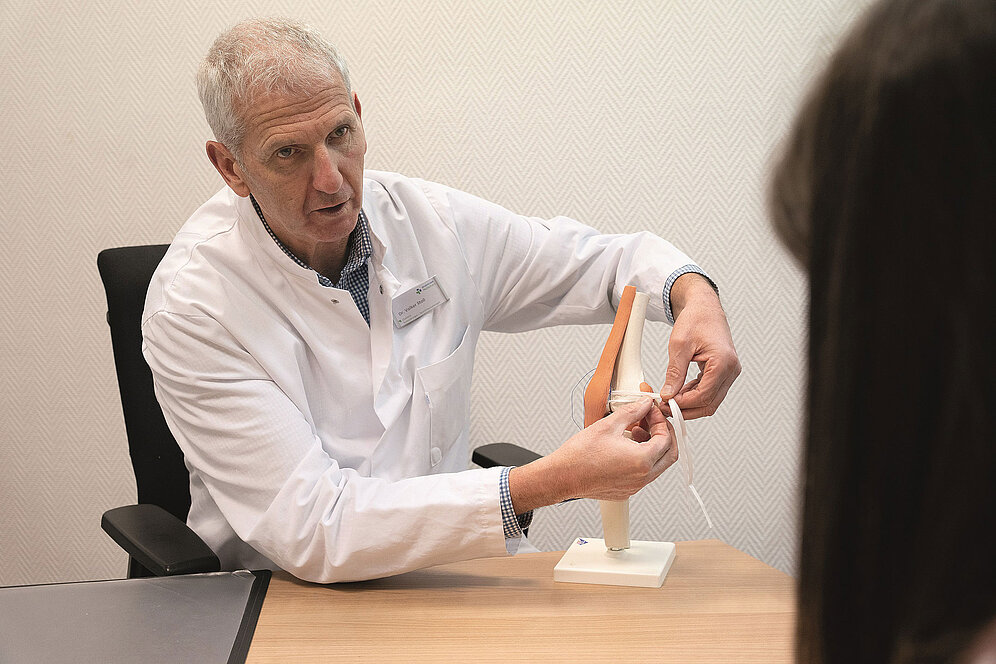This winter season saw more ski injuries than in previous years. Why is that? Dr. Volker Stoll, head physician for knee surgery and sports traumatology at the Hellersen Sports Clinic, sees several reasons for this. He also explains how ski injuries are treated.
Dr. Stoll, why were there more ski injuries in the 2022/2023 winter season than in previous years?
There are several explanations for this. For example, conditions have changed a lot in recent years. Today, we ski more on artificial snow slopes. In the appropriate weather conditions, the artificial snow is often gummy and icy in the morning. Less experienced skiers then often lose control. In addition, because winters are warmer today, artificial snow becomes slushy in the afternoon. As a result, skiers can no longer turn as well. If they then fall, the boot doesn't always come out of the binding immediately due to the consistency of the snow - but the foot is firmly in the boot and therefore they quickly twist their knee. And especially during vacation periods, the slopes are more crowded, which is why accidents, especially petty accidents, happen more quickly. Many people stand together at the lift, the skis cross and already the skier gets stuck when he wants to get off the chairlift.
But a very crucial reason, which is basically added, is the lack of preparation for the ski vacation. Apart from the fact that many people have not skied for a long time due to the corona pandemic, very few people still prepare for their winter vacation with ski gymnastics. With a sport-specific training the necessary musculature can be built up and thus ski accidents be prevented at the same time. By the way, this applies to almost every sport.
Which skiing injuries occur most frequently?
Because the ski hangs on the foot as a lever and the ski boot sits firmly on the foot at the same time, knee injuries occur most frequently when skiing, especially twisting traumas. And very common are cruciate ligament injuries. For example, the anterior cruciate ligament tears due to twisting. It is not uncommon for the cruciate ligament tear to be accompanied by concomitant injuries, such as injuries to the cartilage, meniscus or internal as well as external ligaments. Then it is very important that the accompanying condition is also treated in order to preserve the knee joint for a long time. Muscle injuries can also occur - especially if the athlete has not warmed up properly. Sufficient warm-up before skiing and the appropriate muscle building and coordination training will protect and support the joints.
When a knee injury occurs, it is also especially important that the injury be treated quickly because the knee joint functions like Swiss clockwork. One gear meshes with the other and if there is a disruptive factor - for example, a torn ligament or damaged cartilage - then the knee joint runs out of control, so to speak, and signs of wear and tear occur prematurely.

How is a cruciate ligament rupture treated and when can I start skiing again?
At the Hellersen Sports Clinic, we specialize in minimally invasive techniques that are suitable for quickly reconstructing the structures. Cartilage as well as the meniscus, the cruciate ligament and the collateral ligaments can be reconstructed. For example, if the cruciate ligament is torn, a cruciate ligamentoplasty is used. In this procedure, we remove a tendon from the knee joint through a minimally invasive incision and replace the cruciate ligament with it. This is the most common method. Several tendons from the body are available for this purpose. The most commonly used is the so-called semitendinosus tendon. In this procedure, the cruciate ligament is replaced by a tendon located next to the knee joint. This is done using a minimally invasive technique, so that only small scars remain and rapid rehabilitation is possible. Increasingly, donor tendons are also implanted in cases of multiple injuries.
How quickly the patient is back on his feet is always very individual. After six months, the patient can usually start sport-specific training. Sports that put a strain on the knee, such as soccer or tennis, should only be resumed after nine to twelve months. This also applies to skiing. Although the season is then over, the patient is usually fit again for the next one.
Press contact
Sarah Burghaus
Head of Marketing, Corporate Communication & PR, Press Spokesperson
sarah.burghaus@hellersen.de
Marie Schulz
Public Relations
marie.schulz@hellersen.de
